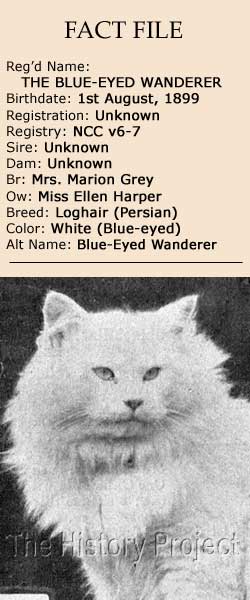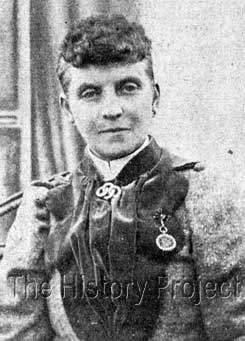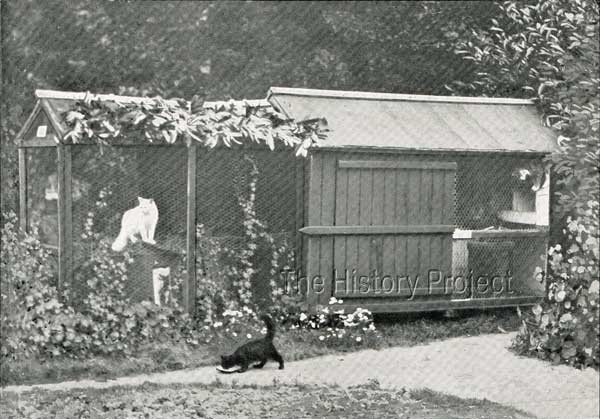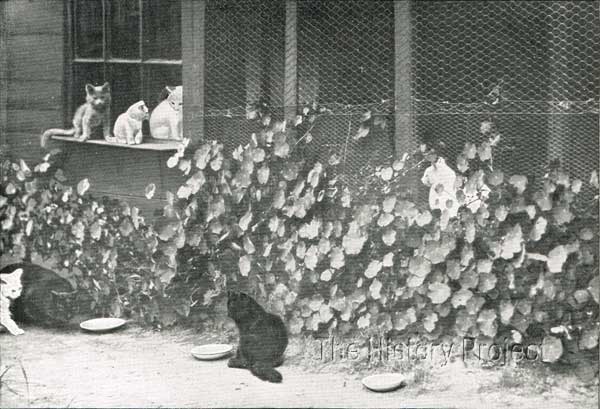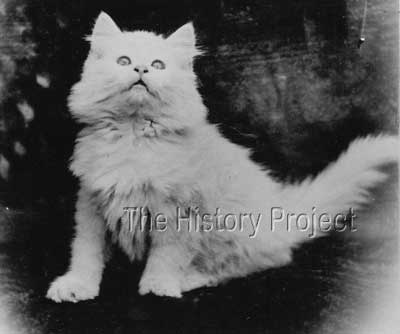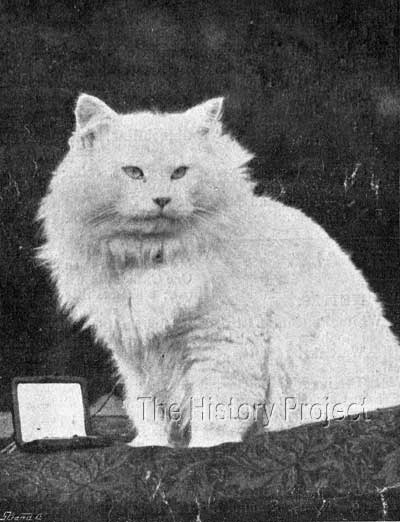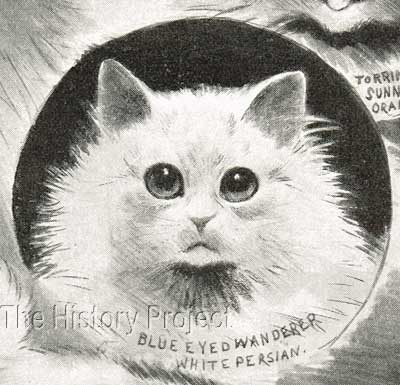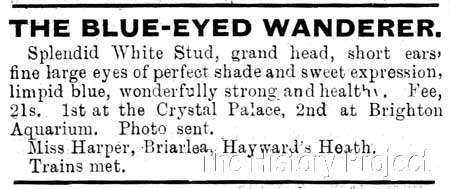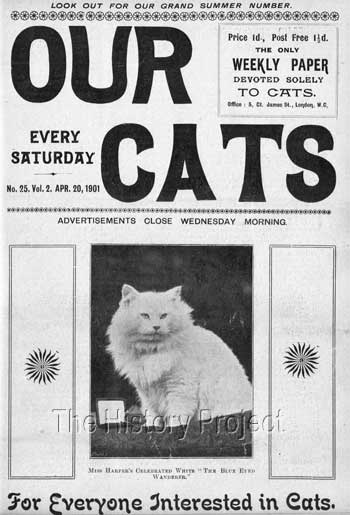 | ||||||||||||||||||||









|
THE BLUE-EYED WANDERER (1899)PHOTOS | SOCIAL MEDIA | REFERENCES
HISTORICAL BACKGROUND:In the world of White Longhairs at the turn of the twentieth century, there were three White Persian males who played a dominant role in the breeding of blue-eyed whites in what was essentially a veritable triumvirate. Chief amongst these was Mrs. Champion's 'White Friar', who had been rehomed with Mrs. Finnie Young in the north, whose lines, when combined with those of 'Ch. Crystal' produced some of the finest white Persians coming out of England at that time. Second, in this triumvirate, was Mrs. White-Atkins's 'White Knight', (aka The White Knight of the Midlands), a massive, broad-skulled male who was seen by many as an appealing alternative. In a number of cases, he was used as an effective outcross for queens from 'White Friar' lines. From a purely breeding perspective, the third male from this triumvirate, was Mrs. Pettit's 'King of the Pearls', who was based in the south; the prime progenitor of a dynasty of other 'Pearls' to come from this cattery. Among his best known progeny were the likes of the lovely 'Piquante Pearl' and 'Beautiful Pearl'. This model however, changed, when viewed from a show perspective; with Miss Ellen Harper's 'Blue-Eyed Wanderer' often replacing Mrs. Pettit's 'King of the Pearls' in the triumvirate. 'Blue-Eyed Wanderer' was a successful show cat, of impressive structure and he offered yet another alternative outcross for those wishing to specialise in the highly-competitive arena of the blue-eyed white longhair. Ever since Mr. A.A. Clarke had exhibited his 'Tim' and 'Miss Whitey' in the 1880s, the White Longhair had enjoyed a pre-eminence in the show ring. Mrs. Cunliffe Lee's unforgettable 'The Masher', known for his size and magnificent coat had left a lasting impression on exhibitors, when he took the cat world by storm at the Crystal Palace Show of 1890. An enthusiastic fancier, Mrs. Lee had paid £21 for this remarkable cat, which also had the grandest of blue eyes. The die had been cast, and there was no shortage of fanciers who wanted to follow along a similar path. PARENTAGE & OWNERSHIP:
Unknown
Unknown
| Unknown
The Blue-Eyed Wanderer, Aug-1-1899, White, M
| Unknown
Unknown
Unknown
Although the parentage of 'The Blue-Eyed Wanderer' is unknown, we do have a record of his first owner, who may or may not have been his breeder. That is Mrs. Marion Grey, who is listed as his owner in both the Cat Club Register2 and in the National Cat Club registration listings published in Our Cats on 8th December, 1900.2
In a brief but revealing snippet written by Miss Frances Simpson in her chapter on Whites from The Book of The Cat, she gives a short account of the well-known prize-winners among White Persian stud cats of the day: "Miss Harper's 'Blue-eyed Wanderer' has great quality and lovely texture of coat. He was in truth a wanderer in the streets of a London suburb, and, although labelled 'breeder and pedigree unknown,' he has almost always held his own in the white classes at our largest shows."12 Evidence of his subsequent transfer to his new owner Miss Ellen Harper is found in the 22nd December 1900 edition of 'Our Cats', which reports: "Miss Harper has bought The Blue-Eyed Wanderer, that superb white, from Mrs. Grey. He is healthy and in good fettle just now, and his present owner having placed him at stud in our columns, is looking forward to A1 kittens, with balls of snow and sapphire eyes."12 Miss Ellen Harper, was already well-established in the cat world before she took on White Persians. She began around 1891 and had previously taken a specialty interest in white shorthairs with blue eyes, and had carried off numerous prizes with these from the Crystal Palace with charming specimens of that variety. She then broadened her horizons and took on longhairs, again specialising in mainly whites. From a Who's Who in the Cat World listing published in May 1901, we find a list of some of the well-known cats she had bred, which included'Pharoah II', 'III', and 'V', 'White Bundle', 'Syringa', 'Crystal Chat Blanc', 'Cherub Queenie', 'Pansy Khedive', 'Blue Waterloo II', and 'III' (all White!).13 One of her earlier stud males with a high profile as a third-tier foundation cat was her Blue, 'Waterloo' who was never shown due to having an injury to his ear. Having formerly resided in Brighton, she had moved to Hayward's Heath where she was the philanthropic proprietor of a Home for Cats. Her intense sympathy with cats, and her lengthy experiences of their ways and their ailments, made her Cat's Home extremely popular among the fanciers and owners of cats in the south.
SIBLINGS & SHOWS:Due to his 'unknown' parentage, there are no siblings of record for 'The Blue-Eyed Wanderer'. However, he was shown very successfully as indicated by Miss Simpson. Known wins include: 1st, at the Crystal Palace, 1900; 1st, at Harrogate, 1901; and 1st, at Midland Counties Cat Club, 1902. But, there were many more. The following are extracts taken from a number of show reports in the latter part of 1900. Brighton Show: - held at the Aquarium on November 14th and 15th, 1900. Judge for the class was Miss Hester Cochran: "Longhaired Black or White male or female (11). 1st,two Specials and Medal, Miss White Atkins 'White Knight', very large cat, beautiful head and eyes, not in full coat; 2nd, Mr. M Grey's 'Blue-eyed Wanderer', very good eyes and coat, nice cobby shape, fails to winner in head; 3rd, Mrs. Herring's 'Prince Zangi' fine cat, nice eyes and coat."19 The Cat Club Show: - held at St. Stephens Hall, Westminster,on January 15th and 16th, 1901. Judge for the class was Mr. Enoch Welburn. This show saw a reversal of the previous placements: "White Males (7 entries). Colour pure white, eyes blue - 1st, Mrs. Harper's 'Blue-Eyed Wanderer, with a grand head, frill, and coat was shown in spotless condition. He is a good all-round cat, and won the Special for the Best White in the Show. 2nd, Miss White Atkins, 'White Knight'. Large with an especially good head, lovely deep blue eyes, but fails in nose, and a trifle out of coat. Suffering from deceased mouth. Had before the show closed to be taken away by the vet. 3rd, Mrs. Pettit's 'Ch.King of Pearls'. Intensely blue eyes, nice ears, a trifle long in face, and out of frill. Have seen him looking better."20 BREEDING & PROGENY:Most of the registrations of progeny sired by 'The Blue-Eyed Wanderer' appear to have been between 1901 and 1906. However, the records that are available are clearly incomplete, which is often the case. The following are some of his identifiable progeny from various queens:
Another blue-eyed white kitten out of 'Water Lily', with date of birth unknown, was 'White Cherub' who is shown in the image below. This appears on a breeders postcard, in the archives of The Harrison Weir Collection and in Miss Harper's own handwriting on the reverse, the kitten is clearly identified as 'White Cherub', by 'Blue-Eyed Wanderer' out of 'Water Lily'.
Blue-Eyed Kitty is also shown as the dam of 'Blue-Eyed Coral' (CFA 57 v1)¹? a blue-eyed white female bred by Miss Harper and exported to Mrs. H.G. Dykhouse, of Grand Rapids in the United States. 'Coral' was born March 5th, 1906 and her sire was 'White Hyacinth',(NCC:4872) a blue-eyed white son of 'Blue-Eyed Wanderer' and 'Putey Putey'.
Other progeny include a blue-eyed white male named 'Crusader', who was by 'Blue-Eyed Wanderer' and out of 'Buckingham Pearl'. This combination is only recorded behind the registration of a cat found in Volume 4 of the Studbook of the Cat Fanciers Association. His dam 'Pearl' was of course, sired by Mrs. Pettit's 'King of Pearls' ex 'Peerless Pearl' showing the perceived and actual desirability of combining the lines of two highly valued white males. No records have been found in English records however, as to his date of birth, breeder or owner.18 Yet another is a blue-eyed white female, registered as 'Timfy', who was by 'Blue-Eyed Wanderer' out of a queen named 'Fifine'. 'Timfy' was bred and retained by A. Vaughan Williams.21 The above list is not exhaustive, but does give an indication of Wanderer's popularity as a stud, and his ability to consistently produce blue-eyed whites to order! PHOTOS:
SOCIAL MEDIA :
In Summary: We must surely admire the tenacity and studious progress of Miss Ellen Harper in venturing into the world of the blue-eyed White longhair and achieving considerable success against what must have seemed at times, to be almost insurmountable odds. No doubt her prior experience as a breeder of blue-eyed white shorthairs, gave her a good grounding, and in running a Cat's Home, she would have gained valuable insights into feline ailments through careful observation. Through this she would have built up a wealth of knowledge, allowing her to detect and/or diagnose any potential risks early on, thereby giving an opportunity to intervene before they could take hold. In short, after hard work and study in one breed, she transferred her knowledge to another and executed a successful campaign, which resulted in consistent wins with numerous cats. This reinforces two valuable lessons in breeding. One, that it pays dividends to study first and gain knowledge before diving into a breed; and two, that you need to be both ready and able to recognise and take up a valuable opportunity when it arrives, possibly unexpectedly. Lastly, we gain a clearer insight into Miss Ellen Harper's character, from an 'Opinion' which is quoted at the bottom of her entry into the Cat World's Who's Who. It reads: "I should like to see the surplus proceeds from the various cat shows devoted to the humane purposes of aiding the different Homes for Stray Cats, as is done already in America." Such a comment would have no doubt gladdened the heart of Harrison Weir upon reading it, and it is easy to imagine him responding with a resounding "Hear hear!" REFERENCES:
Registers associated with this article include The Incorporated Cat Fanciers Association of Great Britain (TICFAGB), National Cat Club (NCC), The Cat Club (CCR), Beresford Cat Club (BCC), Feline Federation Francaise (FFF), Siamese Cat Registry (SCR), US Register & Studbook for Cats (USR)including Supplement(USRS), The Studbook of the American Cat Association (ACA), and the Studbook & Register of the Cat Fanciers' Association (CFA).
|
|||||||||||||||||||
Home | Cats | Gallery | Clubs | People | Artifacts | Articles | Updates | Contact Us ©The CFA Foundation, Inc and The Harrison Weir Collection
|
||||||||||||||||||||
